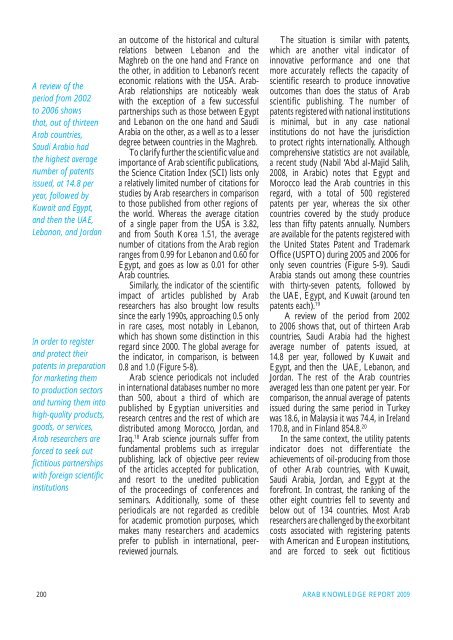Arab Knowledge Report 2009: Towards Productive
Arab Knowledge Report 2009: Towards Productive
Arab Knowledge Report 2009: Towards Productive
- No tags were found...
Create successful ePaper yourself
Turn your PDF publications into a flip-book with our unique Google optimized e-Paper software.
A review of theperiod from 2002to 2006 showsthat, out of thirteen<strong>Arab</strong> countries,Saudi <strong>Arab</strong>ia hadthe highest averagenumber of patentsissued, at 14.8 peryear, followed byKuwait and Egypt,and then the UAE,Lebanon, and JordanIn order to registerand protect theirpatents in preparationfor marketing themto production sectorsand turning them intohigh-quality products,goods, or services,<strong>Arab</strong> researchers areforced to seek outfictitious partnershipswith foreign scientificinstitutionsan outcome of the historical and culturalrelations between Lebanon and theMaghreb on the one hand and France onthe other, in addition to Lebanon’s recenteconomic relations with the USA. <strong>Arab</strong>-<strong>Arab</strong> relationships are noticeably weakwith the exception of a few successfulpartnerships such as those between Egyptand Lebanon on the one hand and Saudi<strong>Arab</strong>ia on the other, as a well as to a lesserdegree between countries in the Maghreb.To clarify further the scientific value andimportance of <strong>Arab</strong> scientific publications,the Science Citation Index (SCI) lists onlya relatively limited number of citations forstudies by <strong>Arab</strong> researchers in comparisonto those published from other regions ofthe world. Whereas the average citationof a single paper from the USA is 3.82,and from South Korea 1.51, the averagenumber of citations from the <strong>Arab</strong> regionranges from 0.99 for Lebanon and 0.60 forEgypt, and goes as low as 0.01 for other<strong>Arab</strong> countries.Similarly, the indicator of the scientificimpact of articles published by <strong>Arab</strong>researchers has also brought low resultssince the early 1990s, approaching 0.5 onlyin rare cases, most notably in Lebanon,which has shown some distinction in thisregard since 2000. The global average forthe indicator, in comparison, is between0.8 and 1.0 (Figure 5-8).<strong>Arab</strong> science periodicals not includedin international databases number no morethan 500, about a third of which arepublished by Egyptian universities andresearch centres and the rest of which aredistributed among Morocco, Jordan, andIraq. 18 <strong>Arab</strong> science journals suffer fromfundamental problems such as irregularpublishing, lack of objective peer reviewof the articles accepted for publication,and resort to the unedited publicationof the proceedings of conferences andseminars. Additionally, some of theseperiodicals are not regarded as crediblefor academic promotion purposes, whichmakes many researchers and academicsprefer to publish in international, peerreviewedjournals.The situation is similar with patents,which are another vital indicator ofinnovative performance and one thatmore accurately reflects the capacity ofscientific research to produce innovativeoutcomes than does the status of <strong>Arab</strong>scientific publishing. The number ofpatents registered with national institutionsis minimal, but in any case nationalinstitutions do not have the jurisdictionto protect rights internationally. Althoughcomprehensive statistics are not available,a recent study (Nabil ‘Abd al-Majid Salih,2008, in <strong>Arab</strong>ic) notes that Egypt andMorocco lead the <strong>Arab</strong> countries in thisregard, with a total of 500 registeredpatents per year, whereas the six othercountries covered by the study produceless than fifty patents annually. Numbersare available for the patents registered withthe United States Patent and TrademarkOffice (USPTO) during 2005 and 2006 foronly seven countries (Figure 5-9). Saudi<strong>Arab</strong>ia stands out among these countrieswith thirty-seven patents, followed bythe UAE, Egypt, and Kuwait (around tenpatents each). 19A review of the period from 2002to 2006 shows that, out of thirteen <strong>Arab</strong>countries, Saudi <strong>Arab</strong>ia had the highestaverage number of patents issued, at14.8 per year, followed by Kuwait andEgypt, and then the UAE, Lebanon, andJordan. The rest of the <strong>Arab</strong> countriesaveraged less than one patent per year. Forcomparison, the annual average of patentsissued during the same period in Turkeywas 18.6, in Malaysia it was 74.4, in Ireland170.8, and in Finland 854.8. 20In the same context, the utility patentsindicator does not differentiate theachievements of oil-producing from thoseof other <strong>Arab</strong> countries, with Kuwait,Saudi <strong>Arab</strong>ia, Jordan, and Egypt at theforefront. In contrast, the ranking of theother eight countries fell to seventy andbelow out of 134 countries. Most <strong>Arab</strong>researchers are challenged by the exorbitantcosts associated with registering patentswith American and European institutions,and are forced to seek out fictitious200 ARAB KNOWLEDGE REPORT <strong>2009</strong>
















